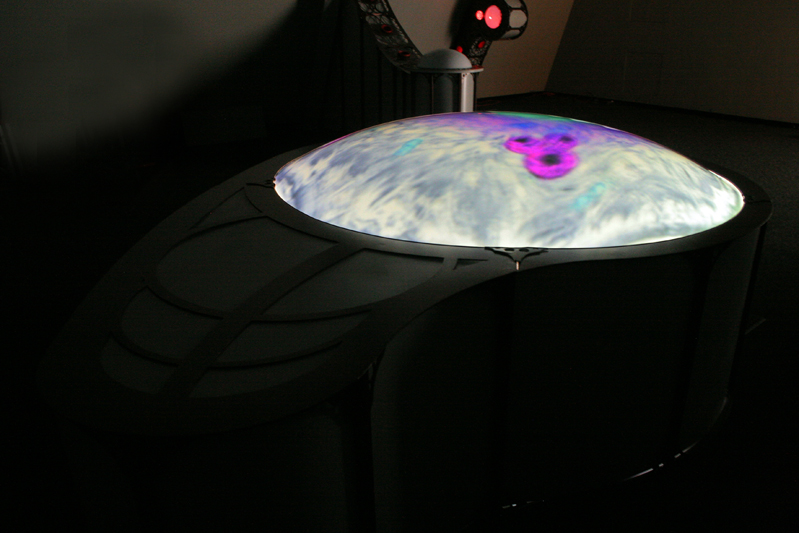New gallery in Kent Square premieres with eight exhibitions

Beginning Friday, Sept. 25, a new gallery at 216 Kent Square, will feature eight inaugural interactive, new media art exhibitions.
The Experiential Gallery for creative technologies is an example of the collaboration of the arts, technology and education at Virginia Tech in support of the university’s Center for the Arts at Virginia Tech, the Arts Initiative, and the university’s focus on creative technologies. Gallery hours beginning Friday, Sept. 25 are Tuesdays, Wednesdays, and Fridays from noon-2 p.m. and 6-8 p.m.; the exhibitions are on display through December.
The inaugural exhibitions of the Experiential Gallery for creative technologies are
- Paspahegh Project by Dane Webster, assistant professor and area coordinator of creative technologies in the College of Architecture and Urban Studies. The virtual Paspahegh project is a 3-D virtual re‐creation of a Native American village near Jamestown that was active during the early contact period. The layout and artifacts of the village are entirely based on archaeological data, illustrations, and journals from the period. The Paspahegh project is part of Virtual Jamestown, created by Crandall Shifflett, history professor in the College of Liberal Arts and Human Sciences, a collaborative teaching-learning-research project rich with digital archives of texts, images, and sounds of the Jamestown experience.
- Merging Arts and Engineering via Rapid Prototyping by Chris Williams, assistant professor of mechanical engineering in the College of Engineering. This project uses a relatively affordable rapid‐prototyping machine that allows users to create 3-D models of objects they design with a computer-aided design program. The purpose behind this technology is to provide a bridge between disciplines of the arts and engineering, where users with skills in the arts can find a place in the field of engineering or users with skills in engineering can find a place in the arts. The technology behind rapid prototyping allows for the fabrication of designs by crossing the barriers of physical or creative limitations.
- Movement through MUsic and Visual Art (MMUVA) by Simone Paterson, assistant professor of art in the College of Architecture and Urban Studies. With this project, users respond to music with dance and motion. Using cameras and the MMUVA software, motions are converted into visual representations on a canvas of artistic expression. The highlighted work includes musical influence from Michael Jackson and artistic influence from Jackson Pollock.
- Interactive Taiji by Ico Bukvic, assistant professor of music in the College of Liberal Arts and Human Sciences. Interactive Taiji combines the physical and mental benefits of Taiji (Tai Chi) movements with the context of traditional Chinese music. The program is delivered with the motivating technology of the Wii Fit™ platform. The interactive multimedia arts game for elementary‐aged children incorporates the use of webcam technology and software algorithms to drive the simulation by monitoring participant posture and movements.
- Always Uncoupled, by Webster. Always Uncoupled is sensory experience that explores the effect of sound on movement. As visitors pass through the space, a microphone detects sound and translates that sound into movement based on pitch and intensity. In response, the animated hands projected on the wall react by moving in multiple directions.
- Elemental, by Bukvic. Elemental is an aural experience that uses motion‐tracking technology to translate motion into sound. As visitors move through the space, sound is generated to resemble rippling water. The rippling sounds create an intense, ever‐changing soundscape that is unique to each visit and each visitor.
- Dome Garden, by Paterson. The Dome Garden is beautiful exploration of smaller worlds. Through the use of a motion‐detecting camera, visitors will bring to life “bots” that follow the movement along the surface of the dome. These bots, meant to simulate birds or fish, rise to the surface as they are accompanied by magical harp sounds.
- Cyrene Reefs, by Eric Standley, assistant professor of art, College of Architecture and Urban Studies, and Bukvic. Cyrene Reefs is a tactile experience for visitors who generate sounds with movement of their hands. Both sculptures are meant to resemble woodwind instruments with arm holes meant to represent the stops on the instrument. As visitors move their arms in and out of the sculpture, sound is generated in response to these movements.
Cyrene Reefs, Dome Garden, Elemental, and Always Uncoupled were created for the Revo:oveR exhibition, a premiere exhibition of the Taubman Museum of Art in Roanoke, Va. Revo:oveR was on exhibition at the Taubman from November 2008 through March 2009. The installation was a collaboration of Virginia Tech faculty to present new media that engages the senses and encourages visitors to interact with the art.
The Experiential Gallery for creative technologies sponsors are the Center for Creative Technologies at Virginia Tech, the School of Visual Arts in the College of Architecture and Urban Studies, the School of Education in the College of Liberal Arts and Human Sciences, and the Collaboration for the Creative Technologies in the Arts and Design.
Written by Benjamin Woody. Woody, of Midlothian, Va., is a junior majoring in communication in the College of Liberal Arts and Human Sciences.


